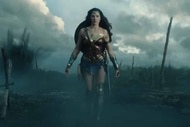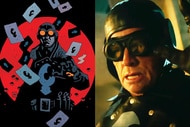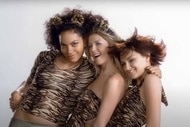Create a free profile to get unlimited access to exclusive videos, sweepstakes, and more!
How important is artist alley at New York Comic Con? Does it really help artists?

Artist alley is at the center of New York Comic Con — literally. At the Javits Center, where America’s second-largest comics convention happens every year, artists and writers set up shop to meet fans, sign autographs, and sell their work in a massive room underneath the main convention floor, flanked by halls where fans line up for hotly contested panels.
The alley might seem like it’s overshadowed by the big Netflix, Amazon, and Marvel presentations, but for comic creators who participate, artists alleys are integral to the experience. And, based on the crowds of convention-goers who made the trek to the alley, it’s important to them too.
“I think they’ve always been integral to conventions. Getting a chance to meet the people who actually make the stuff that you read is kind of an important element,” Tom Richmond, a cartoonist who is best known for his MAD Magazine caricatures, tells SYFY WIRE. “And yeah, people are here to sell stuff, but I enjoy being here to meet the people that actually read and see my work.”
As much as conventions are a celebration of fandom, for comic professionals, they’re also part of the business. Richmond, who has participated in artist alleys at four conventions every year for the past half-decade or so, acknowledges that money has to be taken into consideration.
“It’s kind of important — since it is taking time away from doing work in the studio — that at least I don’t lose any money,” he says. “If I come out here and break even and make a little dough, then I’m happy. But it’s mostly about marketing and getting your stuff out there and getting new readers. That’s as important as bringing home any extra dough.”
For smaller creators, the networking aspect is perhaps even more important. Kate Carleton is an illustrator who has been participating in artist alleys at various conventions for 10 years, and she maintains another studio job in her home state of Florida in addition to her illustration work.
The money she gets when convention-goers purchase her prints is certainly helpful, but she says artist alleys “help me get my stuff out, exposure-wise as well.”
Other comic professionals or representatives for bigger companies can also be found perusing artist alleys, and they’ll sometimes come to her with work opportunities. “It’s fairly random,” Carleton says. “I’ll get offers to do books. I just did something for the Stranger Things book that’s out this month.”
At New York Comic Con, plenty of big names had also set up shop in the same artist alley as their less famous colleagues. Fabian Nicieza, one of the co-creators of Deadpool, isn’t wrong when he says that he’s “a different beast than the average artist alley person.”
If past experiences at New York Comic Con are anything to go on, Nicieza expects one or two hour lines to his artist alley table. “I’m an anomaly, because of Deadpool’s popularity and the fact that I wasn’t on the convention circuit for almost 15 years,” he allows.
Artist alley has room for both the comic celebrities and up-and-coming artists and creators, though. Carelton notes that ReedPop, the company behind New York Comic Con, does a good job of putting the big name creators in strategic spots along the alley.
"They put some of the bigger artists at the ends so that they don’t have a line that gets in the way of other peoples’ tables,” she says. “Sometimes it might help you get exposure from their fans coming over and seeing your stuff as well.”
Peaceful coexistence is key, here, because artist alleys are still a part of the business for comic creators — and the industry isn’t always easy. Nicieza, who by his own admission enjoys a larger level of success than the average creator, says that while artist alleys are important, they shouldn’t be make-or-break for any participant.
“Artist alley should be, for most of us, just a certain amount of water in our buckets per year,” he says. “When you’re a freelance artist or writer, you’ve got to put five or six buckets on the floor and hope enough water drips into each of them that you’ve had a good year. Conventions for me is one bucket, I’ve got five other buckets that I’ve got to pay attention to at the same time.”
There’s something to Nicieza’s bucket metaphor, because there’s a kind of unvarnished atmosphere to artist alley compared to the more polished presentations and panels on the floors above them. It makes sense, though. Artist alley is a chance for comic fans to see how the sausage is made — or illustrated, at least. It’s a place where they can meet the working pros behind their favorite comics, or maybe discover a new artist whose autographed print will soon grace their living room wall. It’s a rare one-to-one interaction with creators in an industry that’s often discussed in terms of corporate monoliths. Artist alley is where comics show their work — and in the process, the creators might make a little scratch.
Click here for SYFY WIRE’s full coverage of New York Comic Con 2019, including up-to-the-minute news, exclusive interviews, and videos.

























